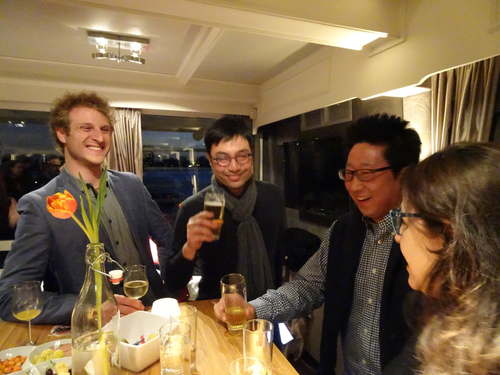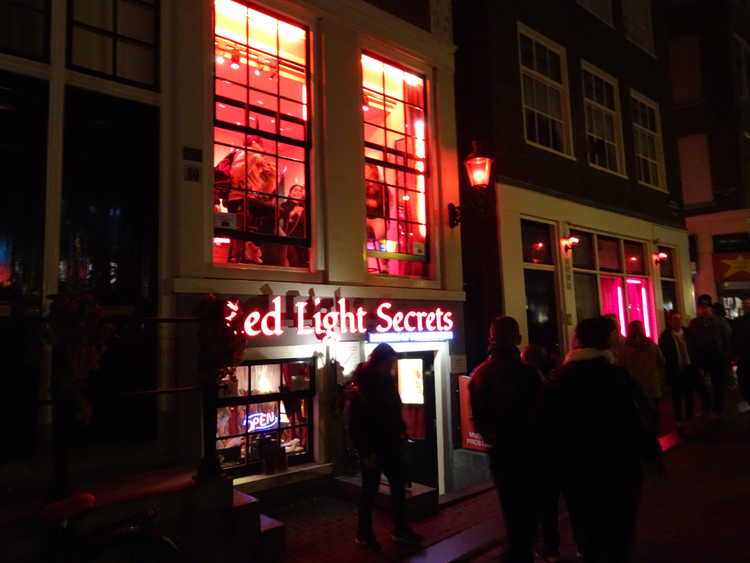The delegates came from a wide variety of disciplines: media studies, cultural geography, literary studies, tourism studies and music sociology. Even from some research fields I hardly knew existed like fan studies. Every day I took a different bike route from the center of Rotterdam to Erasmus University where the conference took place. On Thursday evening we were treated to a boat trip on the Maas river. Looking at the skyline during sunset, talks about slums in Brazil, rituals around PhD defense in different countries, doing ethnographic work among Japanese Mangafans, the changes in the Amsterdam Red Light District…. A wonderful, mind boggling mix of people and perspectives.
Topophilia
The presentations brought us to many different places, from Holy Land theme parks in Brazil and the US, industrial heritage trails in Birmingham, Jurassic Park and Paisley Park, Graceland and Nashville, the Museum of Innocence in Istanbul and U2’s Joshua Tree in Death Valley.
Leonieke Bolderman about music tourism
Real and mediated worlds
On the foreground of all sessions were the complicated relations between the ‘real’ and the mediated world. Roots by Alex Haley for instance, that already mixes facts and fiction, is now turned into a tourist trip in Gambia. An island that did not even play a role in the book is renamed Kunta Kinte. Jason Grek-Martin studied the relation between the book and the place with his students. Marie-Laure Ryan’s keynote was about the different narratives of Pamuk’s novel and the actual Museum of Innocence, where real and imagined worlds and factual and fictual stories meet.
Senses
Do you need to go to the place you study? Marie-Laure Ryan had studied the novel and the catalogue without actually visiting the MoI. Prof. Matts Hills summed up the conference and asked that question. I have been to the Museum of Innocence and think actually being there added so much, but maybe that is because I was the only curator in the conference. We museum people pay much more attention to the materiality of things. Esther Figueroa, the cheerful director of the powerful documentary Jamaica for Sale agreed with me. When we said goodbye after the final session she said: “Of course one has to go there, you have to feel the place”. I agree, senses are so important.
Boattrip on the Maas foto Annemarie de Wildt
Conversations outside the sessions were just as interesting and prof Stijn Reijnders and his team had created enough opportunities to personal and academic exchange, during lunch and dinner and the boat trip. There were professors and PhD students, but also a group of master students from Karlsruhe (originating from Colombia and Peru and other places) and their professor Desmond Wee, who himself has an interesting life route from Singapore through Great Britain and Amsterdam.
“Who or what represents what to whom….”
Desmond Wee had the best quote in his presentation: “Who or what represents what to whom with what, and where and why?” (Mitchell 194:420). He also put ethical questions on the table: what about involving oneself as a scholar in the mediatization of potential heritage, in his case around the ancestral home of Donald Trump in Kallstadt. He studies the documentary Kings of Kallstadt and its effects. This feeling of responsibility for changing or even destroying things through mediatization is shared by some of the Swedish Urban Explorers prof. Andre Jansson talked about. Their paradox is that their search for abandoned urban places collides with their wish to post photo’s of these places on social media: if everyone knows, it becomes a tourist place. Janssen beautifully connected this to the impact of ruins and his own childhood memories of Knossos.
Taboo subject
I talked about the Red Light District in Amsterdam and the way tourists behave in the Red Light Secrets Museum, where they can sit behind the window, performing as a sex worker. Many visitors leave photo’s on Tripadvisor and Instagram. I compared their reactions with the reactions on Marieken Verheyen’s installation Red Light, a real/unreal situation versus and art work. I loved the reaction after my talk of a PhD student from India: “You stretched my mind, it is such a taboo subject in India. I know now that and how one can talk about prostitution". Tourism is more than seeing pretty places. There were sessions about dissonant or dark heritage, such as field trips to WOII battlefields, where present day soldiers connect to the past or American prison-museum tours, surprisingly popular with former inmates.
The presentations were also part of a post-colonial debate, sometimes more, sometimes less explicit. The documentary about Jamaica prompted the question: “Is there hope?” We had just seen how Jamaica’s coast is being sold off to foreign investors by politicians, without benefits for the local black population. Sheer destruction of irreplaceable nature and continued exploitation of people. It was fascinating to hear comments from other parts of the post-colonial former British empire, such as India and Singapore. The global heroes of films and literature carry different meanings in different places, like martial artist Bruce Lee, whose statue can not only be found in Hong Kong but also in Mostar. Bruce Lee's multiple meanings came up in the presentations of Sangkyun (Sean) Kim en Ana Aceska.
Trip through the media landscape
Although at time very theoretical - but then I knew I was amongst scholars and I did at least pick up the most relevant literature in the field of media and cultural studies – it was a great trip through the media/tourist landscape of today, with some very capable guides. Thanks Leonieke, Abby en Nicky for organizing this and good luck with the final stages of your PhD.



